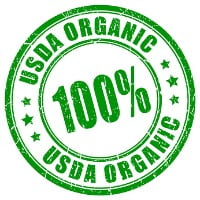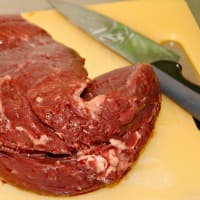FYI: If you buy something through a link on this site I may earn a commission - at NO extra cost to you.
Dog Food 101
Dog food comes in a dizzying selection of commercially prepared formulas and flavors... and while that's great news for Fido, it can be very confusing for you!
Feeding a healthy, balanced diet is one of the most important things you can do to make sure that your puppy, or dog, stays strong and healthy.
To make sure that you're feeding Fido the best formula for his age, size, breed and activity level you'll need to spend a little time on research...and understand both what he needs - and what those confusing dog food labels and packaging are really saying!
This page will help you negotiate the dog food 'minefield' and get it right.
Use these 'quick links' to jump to what you're interested in or simply scroll down to get access to all the information:
- Commercial dog food - the 'big picture'
- Dry dog food v canned
- Customized diets & nutritional needs
- How much to feed your dog
By the time you're finished reading, you'll be armed with all the information you need to make the right choice of food for your pet.
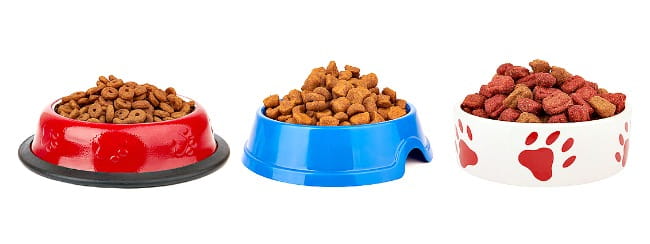
Commercial Dog Food - The Big Picture
Good nutrition will help a dog reach full potential both physically and mentally.
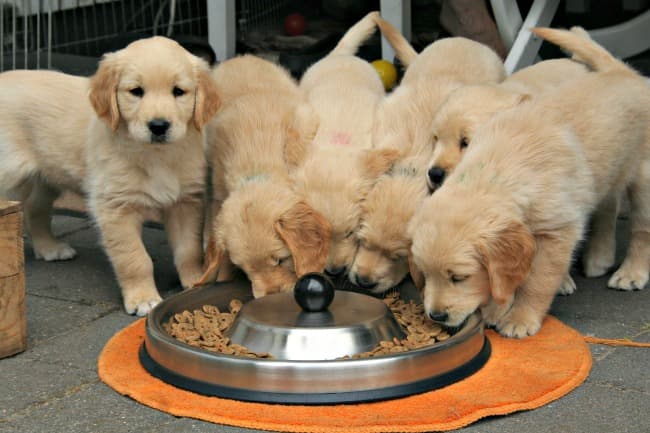
Feeding a puppy or older dog?
Get help finding the best food for your puppy on these pages...
For senior dogs, check out my What To Feed An Old Dog page where you'll find advice that will help you ensure your old dog gets the nutritional balance he needs, plus tips on encouraging him to eat.
Commercial dog food manufacturers who want to produce products which provide 'a complete and balanced diet' have to make sure their foods meet one of two basic AAFCO (Association of American Feed Control Officials) standards through testing and laboratory analysis:
- Adult dog food standard
- Puppy food standard
If a dog food says it is suitable for 'growth' or 'all life stages' it is required to meet the puppy food standard, which is the tougher of the two.
Sounds simple right? Well, yes and no! Although it's easy to check a bag/can or pouch for wording that shows a specific dog food meets one or other of these standards, finding out exactly what that standard demands is a whole different story.
Although the AAFCO sets the standards that commercial dog foods need to meet, it 'does not regulate, test, approve of or certify pet foods in any way.' (see this aafco.org webpage) Those responsibilities lie with the pet food manufacturers and the state feed control officials. If you like numbers, math, and fine print, you can get an idea of the methods used to obtain the nutrient profiles, and what nutrients are included HERE.
When choosing the brand or type of food to give your puppy or dog, it pays to be wary of all the hype and advertising slogans on those bags, cans and pouches. Many of them have no real legal definition (ie 'human grade'), claims that pet foods have a medical application (ie 'reduce inflammation') are considered to be drug claims and are not allowed or verifiable.
You definitely want to feed Fido a premium food, but remember - just because a label contains the word 'Premium' or 'Super Premium' that does not mean the food actually IS of a premium quality!
The only way to know if the food is indeed a premium quality formula is to look closely at the ingredients.
Also, bear in mind that dog food advertising is designed to appeal to HUMANS - because we're the ones paying for it - and what you see on the outside of the bag (ie photos of mouthwatering ingredients) doesn't necessarily reflect what's on the inside.
Because all of this is so challenging I've tried to simplify the whole process a little bit, here's what I would suggest you look when choosing a dog food:
'A complete and balanced diet'
Only manufacturers who adhere to the AAFCO standards are allowed to use this wording.
If you see this on a bag/can of dog food:
'Animal feeding tests using AAFCO procedures substantiate that (name of dog food) provides complete and balanced nutrition for (specific life stage eg. 'puppy' or 'adult')'
It means that food has been evaluated through feeding trials to make sure that it provides adequate nutritional levels which require no supplementation.
If you see this:
'(Name of dog food) is formulated to meet the nutritional levels established by the AAFCO Dog Food Nutrient Profiles for (specific life stage eg. 'puppy' or 'adult').'
It means that certain tests have been done (such as chemical anaylsis & nutrient calculations) to make sure it meets AAFCO requirements.
BUT this is not the same level of evaluation and testing as the first statement and there are no guarantees that the food in question has been tested for nutritional value.
Balanced Nutritional Ingredients
Any dog food formula contains a number of different ingredients and food groups, in specific ratios.
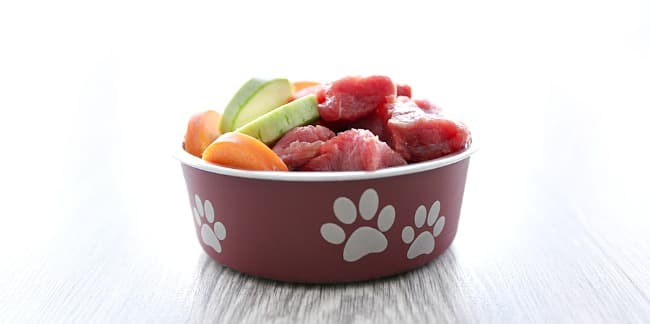
Some ingredients are vital, others are beneficial or desirable, others are things you simply don't want to see in your dogs' diet
Also, depending on the age, size, breed and general health of your puppy the correct balance of nutrients, and specific ingredients, will vary.
The higher on the list an ingredient appears the greater the percentage of it is in the food.
Protein
A well-balanced dog food should contain a good source of high-quality protein (which provides essential amino acids) as one of the first ingredients. Protein is needed for growth, development and a healthy immune system.
Chicken and lamb products are the most popular sources of protein. This can be 'whole chicken', 'whole lamb'.'Chicken meal' or 'lamb meal' etc. is also okay, but make sure the type of meat is specified, 'meat meal' is not a premium ingredient.
A lot of other protein sources are also available including beef, turkey, duck, salmon, bison and more.
Carbohydrates
Carbohydrates supply Fido with the energy he needs to get through his day.They also contain fiber which converts to glucose in his body.
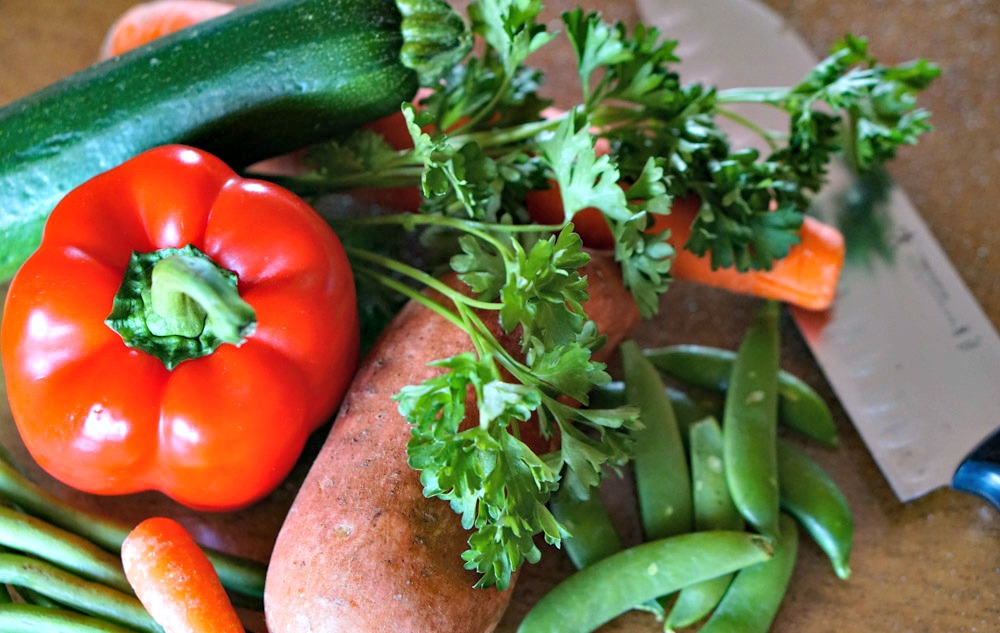
Good sources of carbohydrates include most grains, fruits and vegetables.
Fats
Fat is a valuable source of energy and is also needed to keep your puppy/dogs' coat and skin healthy.In commercial dog food formulas these may be found in muscle meats, or as animal fat or vegetable oils.
Again, a specified source of animal fat such as 'chicken fat' is good, the more generalized 'animal fat' is not.
Vitamins & Minerals
These are vital to your pets' health and it's important that they're supplied in the right quantities and in the correct ratio.
An AAFCO approved food will contain exactly what your pup/dog needs if he is generally healthy and has no specific health issues.
If he has special needs or has a health condition then your veterinarian may recommend additional supplements.
How To Evaluate Specific Dog Food Formulas
You can analyze and compare ingredients in one, or several, dog food formulas using an innovative system that you'll find on my Dog Food Comparisons & Anaylsis page.
You can also see ready-made dog food comparison charts which look at the main ingredients and the balance of nutritional elements in some popular brands here... Dog Food Comparison Charts
about Specialty Dog FOods.....
The dog food market today is becoming more and more diverse and the number and variety of specialty formulas are increasing.
All-natural, organic, hypo-allergenic, grain-free, vegetarian... there are a LOT of different choices.
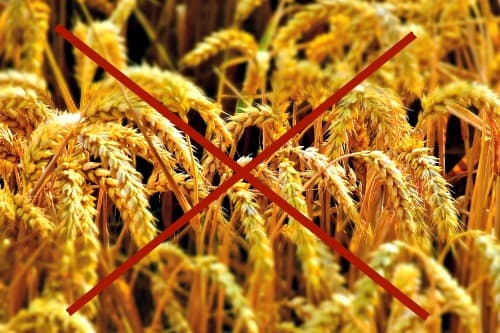
This is great news for dogs, because the quality of the food they eat is SO important. For pets with food allergies or sensitivities, this is especially good because there's bound to be a food that will suit just about everyone.
Organic ingredients are overall healthier and safer for our dogs, and I prefer to eat/buy organic food both for myself and my pets. Check out this page to find out what makes organic better.
There are also the options of feeding your dog a raw diet, or homemade dog food.
Dry Dog Food v Canned
Both these types of food can give your puppy/dog what he needs, and one is not necessarily better than the other.
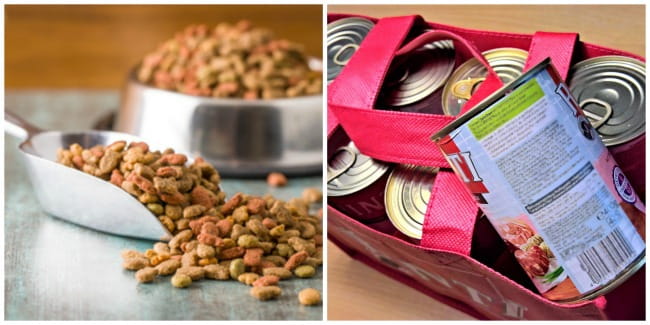
Quality can vary enormously from brand to brand and whether you're feeding a dry, crunchy kibble or a soft, moist canned food, the quality of the ingredients is what counts.
Pay attention to what is IN the food you choose, not every dog food (even those that meet the
AAFCO) is good enough... far from it in fact!
Dry Dog Food
Pros:
- Affordable and economical
- Keeps well in airtight container once bag is opened
- Convenient to use
- Results in firm, regular stools
- Exercises dog's jaws
- Helps remove tartar from certain areas of your dog's teeth
- A good choice for large & giant breeds (generally contains less protein than canned foods)
- Can be left in the bowl all day if you want to free-feed your dog
Cons:
- Higher carbohydrate content
- May contain more artificial preservatives (look for natural ones instead such as Vitamin E)
- Shorter shelf life than canned BEFORE opening
Canned Dog Food
Pros:
- Contains less artificial preservatives than dry food due to canning process
- Higher protein content
- Smells & tastes better to your dog
- Long shelf life BEFORE can is opened
- A good choice for small breeds, young puppies, senior dogs, sick or convalescing dogs because it contains a lot of moisture (up to 80%), is soft and easy to eat and smells enticing.
Cons:
- Short lifespan once OPEN & needs to be refrigerated
- Usually more expensive than dry, cost would be prohibitive for medium-large to giant size dog
- Protein levels too high for large breed puppies
- Can't be left in the bowl for more than an hour or it spoils and bacteria begins to grow
- Produces looser, more frequent stools
So, in my opinion the bottom line is that the type of food you choose should depend on the size/age/health of your puppy or dog and on your budget.
There's no one-size-fits-all formula to help you decide which is best, it's more weighing up the pros and cons and taking into account your budget, lifestyle and personal preferences.
Whichever you go for, just look carefully at the ingredients to make sure that they fit they the criteria of a premium food.
If you take time to browse through all the pages on my site that talk about feeding your dog properly you'll find all the information you need to make that decision.
Customized Diets For Dogs
Not so long ago there were far fewer dog food choices, and most dogs and puppies ate basically the same food.
Today, the industry is much more specialized as scientists and nutritionists have come to realize that different dogs have different nutritional needs.
You'll find puppy and adult food for large breeds, small breeds; giant breeds; senior dogs; active dogs; overweight dogs; dogs with certain medical conditions; breed-specific dog foods and much more.

Each group has very unique and individual requirements which need to be met if they're to stay healthy.
The following is a brief overview of just a few of those different needs...
Customizing your dog's food can mean more than just choosing a breed or size appropriate commercial dog food. There are other options which might appeal depending on your time, budget and personal taste.
Making your own homemade dog food is one option, and feeding a raw dog food diet is another (check out this page for raw dog food recipe ideas). Each one takes more effort than feeding a ready made diet but can be a great choice if they appeal to you.
Nutritional Needs Of Puppies
Puppies are growing rapidly and in order to support that growth their bodies need a diet higher in protein, fat, vitamins and minerals.
Large Breed Puppies need protein values somewhere between 23 -25%, and fat between 12 - 15%.
Small Breed Puppies need higher levels of protein and lower levels of fat. Recommendations put protein requirements between 22 - 29% and fat between 8 - 14%.
Nutritional Needs Of Small Breed Dogs
Small dogs have a high metabolic rate and small tummies. They grow and develop more quickly than larger breeds and usually reach adulthood somewhere around one year of age.
They do best on an energy-dense diet and need small, frequent meals (often two to three meals per day even as adults).
Tiny and toy breeds can suffer from hypoglycemia (low blood sugar levels) if they have to go too long between meals.
Nutritional Needs Of Large Breed Dogs
Large breed dogs grow quickly in the physical sense, but they are growing for a much longer period of time than smaller breeds - not reaching maturity until somewhere between 18 months and 3 years of age.
This growth pattern can put a lot of stress on their developing bone structure and gives them very specific nutritional needs.
As adults they need moderate levels of protein, fat and carbohydrates.
As adults you may also need to watch their weight to prevent obesity and it's associated health/joint issues.
Nutritional Needs Of Active/Working Dogs
A working or super-athletic dog he needs a dog food formula which provides extra calories for energy.
These should also contain highly digestible proteins and fats.
Nutritional Needs Of Dogs With Food Allergies
Obviously if your dog has an allergy to a specific type of food (such as dairy, wheat, beef or whatever) then you need to choose formulas which do not contain that particular ingredient.
Luckily there are many dog foods which are formulated specifically for dogs with sensitive tummies or allergies.
They often contain more exotic and unusual ingredients (because dogs are more likely to be allergic to a common ingredient that they've been eating for a while).
These might include duck, salmon, bison, ostrich, whitefish, sweet potatoes, oats and so on.
This page has tons of information on dealing with allergies of this type... All About Dog Food Allergies.
How Much Should I Feed My Dog?
To start with it's best to follow the guidelines on the bag or can of your chosen brand.
The amount recommended is usually based on your puppy or dogs' age and weight, and is calculated according to recommended calorie intake which makes it a good 'jumping-off' point.
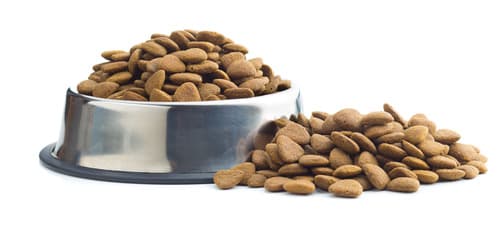
Also, bear in mind that Fido will need less of a good quality, nutrient-dense, complete food than he will of a low quality one which is mostly 'filler'.
Because of this, cheaper foods of inferior quality don't work out less expensive in the long term.
In addition to needing to feed more food per pound of your dog's weight, you may also find yourself paying higher veterinary bills to treat all sorts of health conditions caused by poor nutrition.
Every pup/dog is different and Fido may need more or less than the average recommended amount.
The best way to figure out how much to feed your pooch is to get a good estimate of the number of calories he needs per day, and to choose a food specifically formulated for his age/size.
You can find all the information you need about this on my How Much To Feed Your Dog page.
If you want your puppy to grow up with good eating habits do not free feed (that is, leave his food bowl down and filled at all times). This can lead to all sorts of problems such as obesity, picky eaters, food guarding, housebreaking problems and more.
Instead, divide his daily food requirements by the number of meals he's eating per day and put his food bowl down at set times of the day.
Leave it down for 10 to 15 minutes and then pick it up even if he hasn't eaten it all.
If Fido has gobbled the whole lot down in 2 minutes flat each time, you probably need to go ahead and increase the amount a little.
Alternatively, if he's consistently leaving some food uneaten you need to decrease the amount just a bit.
You'll soon find out what he needs, but like children, puppies go through growth spurts and these needs will change often as they grow, settling down as he reaches adulthood.
The Relationship Between Feeding & Bloat
For extra-large or giant breeds, especially those who have deep chests (such as Great Danes, Irish Wolfhounds etc.) offering smaller, more frequent meals can be an option if they're fast eaters/gobblers.
Eating too quickly can increase the likelihood of a dog developing canine bloat, and 'chow hound' dogs are less inclined to eat this way if they have food freely available to them.
Alternatively, try a Slow Feeder dog bowl which is specifically designed to prevent dogs from gobbling down their meals super-fast (there are several designs and types available).
Although extra-large and giant breeds are more prone to bloat than smaller breeds are, it's important to know that a dog of any size can develop this dangerous condition (especially if they have deep chests/ribcage).
If you follow the advice on this page then you can feel comfortable that you're doing your best to give Fido the nutrition he needs to stay healthy and strong.
When you look at him you'll know you've got it right if his eyes are bright, his coat is shiny, and he's full of energy and bursting with happiness!
you might also like...
- Home
- About Dog Food
FTC Disclosure: Some pages on this site contain affiliate links. I may earn on qualified purchases.
